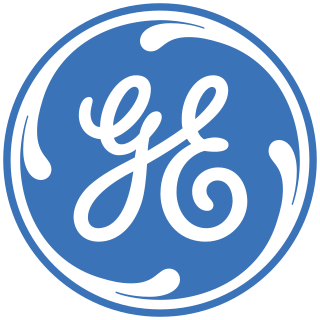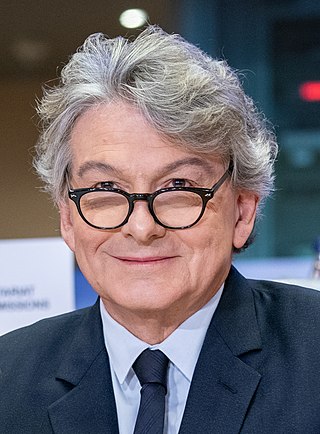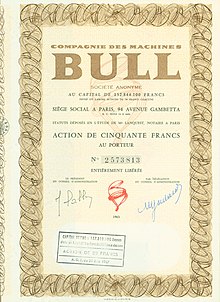
Multics is an influential early time-sharing operating system based on the concept of a single-level memory. Nathan Gregory writes that Multics "has influenced all modern operating systems since, from microcomputers to mainframes."
The Honeywell 6000 series computers were rebadged versions of General Electric's 600-series mainframes manufactured by Honeywell International, Inc. from 1970 to 1989. Honeywell acquired the line when it purchased GE's computer division in 1970 and continued to develop them under a variety of names for many years. In 1989, Honeywell sold its computer division to the French company Groupe Bull who continued to market compatible machines.
The GE-600 series is a family of 36-bit mainframe computers originating in the 1960s, built by General Electric (GE). When GE left the mainframe business the line was sold to Honeywell, which built similar systems into the 1990s as the division moved to Groupe Bull and then NEC.

General Comprehensive Operating System is a family of operating systems oriented toward the 36-bit GE-600 series and Honeywell 6000 series mainframe computers.

Honeywell International Inc. is an American publicly traded, multinational conglomerate corporation headquartered in Charlotte, North Carolina. It primarily operates in four areas of business: aerospace, building automation, performance materials and technologies (PMT), and safety and productivity solutions (SPS). Honeywell is a Fortune 500 company, ranked 115th in 2023. In 2023, the corporation had a global workforce of approximately 95,000 employees. The current chairman is Darius Adamczyk and the chief executive officer (CEO) is Vimal Kapur.

The French Alternative Energies and Atomic Energy Commission, or CEA, is a French public government-funded research organisation in the areas of energy, defense and security, information technologies and health technologies. The CEA maintains a cross-disciplinary culture of engineers and researchers, building on the synergies between fundamental and technological research.

Sophia Antipolis is a 2,400 hectare technology park in southeast France, and as of 2021 home to 2,500 companies, valued today at more than 5.6 billion euros and employing more than 38,000 people counting more than 80 nationalities. The park is known to be Europe's first science and technology hub. The technology park is also a platform, cluster and creation-hub for start-ups.

Thierry Breton is a French business executive, politician, writer and the current Commissioner for Internal Market of the European Union. Breton was vice-chairman and CEO of Groupe Bull (1996–1997), chairman and CEO of Thomson-RCA (1997–2002) and chairman and CEO of France Télécom (2002–2005). In 2005 he entered politics serving as Minister of Economy, Finance and Industry (2005–2007) in the governments of Prime Ministers Jean-Pierre Raffarin and Dominique de Villepin, during the presidency of Jacques Chirac. From 2007 to 2008 he was a professor at Harvard Business School before joining group Atos from 2009 to 2019 as its CEO.

Fredrik Rosing Bull was a Norwegian scientist, information technology pioneer, known for his work on improved punched card machines. Bull was born in Kristiania. In 1907, he finished his studies in civil engineering at the Technical School of Kristiania. In 1916, he was hired as a technical inspector for the insurance company Storebrand, where he developed an interest for punched card technology and began developing one of his own. In 1919, he obtained a patent for his machine, and in 1921 he prepared a team that took over the implementation of the machine at Storebrand. This team provided several new ideas for improving the Bull machine, rendering it superior to Herman Hollerith's device, the precursor to the IBM punched card machine, in use at that time. Bull continued to develop his ideas and improve the machine, which became a success throughout Europe. He was diagnosed with cancer in 1924 and died in 1925 at the age of 42. His patents were later sold in 1931 and constituted the basis for the founding of the French company Groupe Bull, a large information technology company operating in over 100 countries.
The BUNCH was the nickname for the group of mainframe computer competitors of IBM in the 1970s. The name is derived from the names of the five companies: Burroughs, UNIVAC, NCR, Control Data Corporation (CDC), and Honeywell. These companies were grouped together because the market share of IBM was much higher than all of its competitors put together.
Sopra Steria is a European-based consulting, digital services, and software development company with 50,000 consultants. The company is headquartered in Paris and has operations in several countries in Western Europe.

Micral is a series of microcomputers produced by the French company Réalisation d'Études Électroniques, beginning with the Micral N in early 1973. The Micral N was one of the first commercially available microprocessor-based computer.
Plan Calcul was a French governmental program to promote a national or European computer industry and associated research and education activities.
The following outline is provided as an overview of and topical guide to computing:

S.A.S. HPI Groupe is a French company established in 1993 which engages in radio broadcasting and is based in Courcouronnes, France.
The Bull Gamma 60 was a large transistorized mainframe computer designed by Compagnie des Machines Bull. Initially announced in 1957, the first unit shipped in 1960. It holds the distinction of being the world's first multi-threaded computer, and the first to feature an architecture specially designed for parallelism.
Alice Recoque was a French computer scientist, computer engineer and computer architecture specialist. She worked on the designs of mini-computers in the 1970s and led research focused on artificial intelligence.

LogAbax was a French computer brand. Founded in 1942, the company was one of France's pioneers in computer manufacturing. The name is composed of two abbreviations: Log from logarithm and Abax from abacus.

The Société d'électronique et d'automatisme (SEA) was an early French computer manufacturer established in 1947 by electrical engineer François-Henri Raymond, which designed and put into operation a significant portion of the first computers in France during the 1950s.












